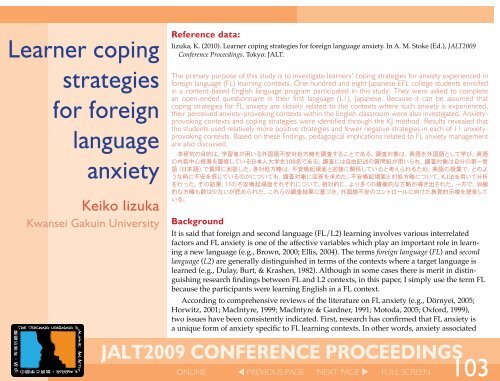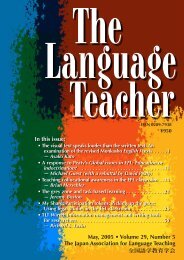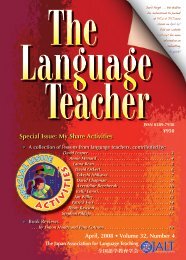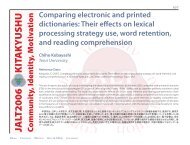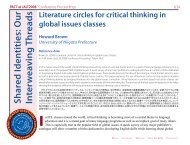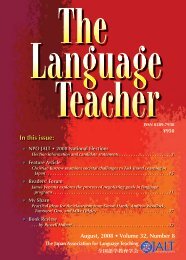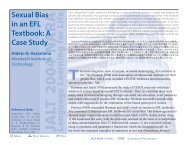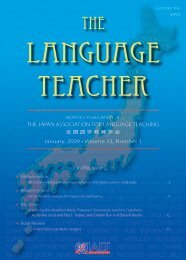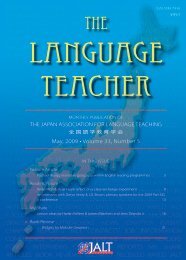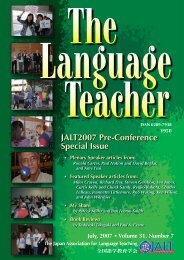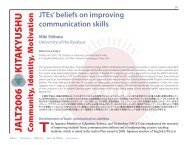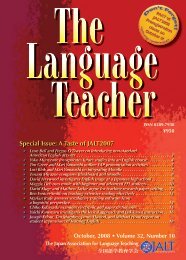Learner coping strategies for foreign language ... - JALT Publications
Learner coping strategies for foreign language ... - JALT Publications
Learner coping strategies for foreign language ... - JALT Publications
You also want an ePaper? Increase the reach of your titles
YUMPU automatically turns print PDFs into web optimized ePapers that Google loves.
Iizuka • <strong>Learner</strong> <strong>coping</strong> <strong>strategies</strong> <strong>for</strong> <strong>for</strong>eign <strong>language</strong> anxietywith FL learning is distinguishable from anxieties experiencedin other situations. The second issue concerns FL anxiety in relationto FL learning. Although some researchers have highlightedthe potential facilitating nature of anxiety in FL learning (Scovel,2001; Spielmann & Radnofsky, 2001) and others have evenclaimed that anxiety is a consequence of poor <strong>language</strong> learning(Sparks, Ganschow, & Javorsky, 2000), numerous empirical studieshave revealed the negative relationships between anxietyand learning in FL contexts.Because of its debilitating nature in relation to FL learning, FLanxiety is widely considered as a factor to be reduced and variouspedagogical suggestions <strong>for</strong> anxiety reduction have been proposedby various authors. These suggestions have generally highlightedwhat teachers can do to help students reduce or manage FL anxiety.For example, in terms of classroom management, teachersare expected to create a supportive and cooperative classroomatmosphere, to develop learner community, or to introduce groupworkactivities in an attempt to create a low-anxiety classroom(e.g., studies reported in Horwitz & Young, 1991; Young, 1999; <strong>for</strong> acomprehensive review, see Ox<strong>for</strong>d, 1999; Young, 1991).On the other hand, few studies have attempted to investigatewhat students are actually doing when they experience FLanxiety (e.g., Kondo & Yang, 2004, 2006). In order to furtherdevelop more practical teachers’ <strong>strategies</strong> to help students whoare struggling with FL anxiety, I think there is a need to focus onnot only pedagogical ideas from the researchers and instructors,but also the voices of students who react in different ways to FLanxiety. There<strong>for</strong>e, this study addressed the issue of learners’<strong>coping</strong> <strong>strategies</strong> <strong>for</strong> FL anxiety. Two research questions wereinvestigated as follows:1. What kind of contexts do learners perceive as anxietyprovoking?2. What kind of <strong>strategies</strong> do learners use to cope with FLanxiety?<strong>JALT</strong>2009 CONFERENCEPROCEEDINGSMethodParticipantsThis study involved students enrolled in an English <strong>language</strong>program (hereafter, EC, which is a vernacular term used by thestudents) at a university in Japan. As of 2005, the time whenthis survey was conducted, the program was a required, foursemester(EC1-EC4), content-based integrated skills programthat enrolled about 1000 students. Each semester consistedof four classes a week (e.g., writing, seminar, listening, andpresentation), and all the students in the program followed thesame syllabus and used the same materials despite the classesbeing <strong>for</strong>med according to the students’ English level (i.e.,TOEFL scores) (Balint, 2005; Quinn & Nachi, 2004). The surveywas administered to 108 students. With the exception of threenon-responding students, data collected from 105 students wereincluded in the analysis.MaterialA Japanese version of an open-ended questionnaire was used(see Appendix), which posed two questions: “When do youexperience anxiety in EC classes?” and “How do you cope withsuch anxiety?”ProcedureEC4 students from six classes completed the questionnaire at thebeginning of a regular class in December 2005. After a brief Englishannouncement by the instructors, the researchers explainedthe point of the survey in Japanese and distributed the questionnaires.The students were asked to respond to the questions inJapanese.104
Iizuka • <strong>Learner</strong> <strong>coping</strong> <strong>strategies</strong> <strong>for</strong> <strong>for</strong>eign <strong>language</strong> anxietyAnalysisBecause the collected answers were potentially chaotic as awhole, I adopted the KJ method to categorize the answers, identifyingsome similarities in the students’ voices. The KJ methodwas developed by Kawakita Jiro (1967, 1970), an anthropologist.It is an inductive approach used to systematically analyzequalitative data as typified by field notes. The basic process ofthe KJ method consists of four phases: card making, groupingand naming, chart making, and explanation.In this study, all responses including “nothing special” weretranscribed on postcards (card making). Most students respondedwith more than one idea <strong>for</strong> each question and those ideas weretranscribed separately (i.e., one idea per card). Meanwhile, becauseI assumed that the reported <strong>strategies</strong> <strong>for</strong> dealing with FLanxiety were closely related to the contexts where such anxietywas experienced, each student’s responses about anxiety-provokingcontexts and <strong>coping</strong> <strong>strategies</strong> were both described on thesame card (see Figure 1). At this stage, 181 cards were created.In the second phase, the cards were shuffled, spread out onthe floor and grouped according to the similarities among thedescriptions on the cards (grouping). Each group was given a titlethat represented the students’ responses in a group (naming).In an attempt to ensure objectivity, grouping and naming werebased on discussions between the researcher who had previouslybeen enrolled as a student in EC classes, and a colleaguewho was only vaguely familiar with the EC program. Based onmy assumption that <strong>coping</strong> <strong>strategies</strong> were closely related to thecontexts where each learner experiences FL anxiety, we firstlyattempted to identify the groups of anxiety-provoking contexts,and the reported <strong>coping</strong> <strong>strategies</strong> were withheld at this stage.In order to create superordinate groups of anxiety-provokingcontexts, the process of grouping and naming was repeatedthree times in total, and the original 181 cards were categorizedinto 86, 38, and finally 12 groups.<strong>JALT</strong>2009 CONFERENCEPROCEEDINGSOne student’s response1. Anxiety-provoking contexts: Presentations, discussions2. Strategies: To prepare them well in advance; to think,“It’s no use worrying about them.”Card makingThe four cards below were created from the above student’sresponses.PresentationsTo prepare them wellin advancePresentationsTo think, “It’s no useworrying about them.”DiscussionsTo prepare them wellin advanceDiscussionsTo think, “It’s no useworrying about them.”Figure 1. Example of card making105
Iizuka • <strong>Learner</strong> <strong>coping</strong> <strong>strategies</strong> <strong>for</strong> <strong>for</strong>eign <strong>language</strong> anxietyIn the third phase, I attempted to clarify the relations amongthe 12 superordinate groups by arranging them on a large sheetof paper, creating a chart (chart making). Finally, the KJ methodof categorizing the anxiety-provoking contexts was completedwith the explanation provided in the following section (explanation).With regards to <strong>coping</strong> <strong>strategies</strong>, the KJ method was alsoapplied in order to categorize the students’ responses accordingto each of the 11 anxiety-provoking contexts except one groupnamed “no special anxiety.”ResultsAnxiety-provoking contextsThis section addresses the first research question. Through theKJ method, 12 anxiety provoking contexts in ECs were identifiedas follows ([n] = the number of students whose responseswere included in each group):1. Anxiety about participating in class or anxiety experiencedin the classroom, which was provoked by a lack ofpreparations <strong>for</strong> class [22]2. When students speak English in front of the class (e.g.,presentation or group discussion) [19]3. When students struggle to understand what classmatesand especially teachers talk about, and have difficulty inkeeping up with class [19]4. When students have difficulty in making their points inEnglish or in getting through to their interlocutors [15]5. When students have trouble expressing their ideas althoughthey are required to do so [15]6. When students interact with classmates who can speakEnglish fluently (e.g., returnee students or students withexperience studying abroad) [11]7. Anxiety the student felt about his/her own English proficiency[11]<strong>JALT</strong>2009 CONFERENCEPROCEEDINGS8. Anxiety about whether or not they can pass the course [7]9. When students interact with not-so-close classmates orteachers with whom they feel a psychological distance [5]10. Anxiety arising just be<strong>for</strong>e a presentation, due to fear ofmaking a mistake [4]11. Anxiety about whether or not they can finish assignmentsor complete assignments satisfactorily [3]12. No special anxiety [6]The possible relationships among these contexts are describedin Figure 2. The above numbers 1-12 correspond tothe numbers in the figure. With the exception of (12) No specialanxiety, 11 groups appeared categorizable as anxiety-provokingcontexts in ECs. According to my experience in ECs as a learner,classes basically consisted of group discussions and presentations,which were based on a large number of preparationassignments. Since 2005, students have been required to attendEC classes and must not miss more than three classes in orderto earn credits <strong>for</strong> the course. On the basis of this rule regardingattendance, anxiety <strong>for</strong> (1) Participating in class without enoughpreparation, (8) Passing the course, and (11) Class assignmentswould be attributed to the features of ECs, and then they can becategorized into one group: Anxiety Related to ECs.Next, anxiety was experienced when students were (2) SpeakingEnglish in front of the class and they had (3) Difficulty in followingteachers’ (and classmates’) talk and (4) Difficulty in making one’spoint in English. Because these situations seemed to be associatedwith English use and English processing, I labeled them as AnxietyRelated to English Communication.Meanwhile, the following three types of anxiety, (5) Troublein expressing ideas, (9) Interactions with not-so-close classmates, and(10) Fear of making a mistake in presentations, would perhaps beobserved not only in English learning contexts but also in first<strong>language</strong> (L1) situations. In this case, students might be more106
Iizuka • <strong>Learner</strong> <strong>coping</strong> <strong>strategies</strong> <strong>for</strong> <strong>for</strong>eign <strong>language</strong> anxietyconcerned about general interpersonal evaluations rather thanAnxiety Related to English Communication, which can be consideredas learners’ concerns specifically related to <strong>language</strong> use or<strong>language</strong> processing. However, it is plausible to think that thesetypes of general anxiety are strengthened in English learningcontexts where college students cannot appear as intelligent,sensitive, or witty as they can in L1 situations (Horwitz, Horwitz,& Cope, 1986; Horwitz, 2001; Yashima, 2004). There<strong>for</strong>e, I labeledthis group as General Anxiety Exacerbated in English Contexts.With regard to the issue of (6) Interactions with classmates whospeak fluent English, it is likely to share both features of AnxietyRelated to ECs and Anxiety Related to English Communication.Upon entering college, most Japanese students have had just sixyears of previous English study at junior and senior high school.There<strong>for</strong>e, interactions with classmates who can speak Englishfluently as typified by returnee students might be one significantaspect of ECs. In addition, during the class, students areencouraged to use English; there<strong>for</strong>e concerns about interactionswith returnee students would also be associated with AnxietyRelated to English Communication.Finally, (7) Anxiety related to one’s own English proficiency isnamed Self-perception because it relates to students’ self-perceptionof their own English proficiency. I arranged it separatelyfrom the other three anxiety-provoking groups, because selfperceptioncould be viewed as internal communications withinthe students’ minds, while the other anxiety-provoking groupsinvolve direct interactions with classmates, teachers, or materialsin the external learning environment.Anxiety Related to ECs1. Participating in classwithout enough preparation8. Passing the course11. Class assignments6. Interactions with classmateswho speak fluentEnglishFL Anxiety in ECsSelf Perception7. Anxiety related to one’sown English proficiencyAnxiety Related to EnglishCommunication2. Speaking English in front of the class3. Difficulty in following teachers’ (andclassmates’) talk4. Difficulty in making one’s point inEnglishGeneral Anxiety Exacerbatedin English Contexts5. Trouble in expressing ideas9. Interactions with not-socloseclassmates10. Fear of making a mistakein presentationsNo anxiety12. No special anxietyFigure 2. Possible relations among 12 anxiety-provoking contexts in EC classrooms<strong>JALT</strong>2009 CONFERENCEPROCEEDINGS107
Iizuka • <strong>Learner</strong> <strong>coping</strong> <strong>strategies</strong> <strong>for</strong> <strong>for</strong>eign <strong>language</strong> anxietyDiscussion and conclusionAs <strong>for</strong> the contexts that the students perceived as anxietyprovoking,the present findings show similarities with previousresearch on FL anxiety. First, previous studies have revealed theclose relationship between self-perceived FL proficiency and FLanxiety (e.g., MacIntyre, Noels, & Clement, 1997; Price, 1991).More specifically, Young (1991) pointed out that learners with alow self-perceived FL proficiency are “the likeliest candidates”(p. 427) <strong>for</strong> FL anxiety. Some participants in this study mightbe also struggling with anxiety stemming from their own lowlevels of self-perceived proficiency.Second, Anxiety Related to English Communication shares similaritieswith the components of the Foreign Language ClassroomAnxiety Scale (FLCAS) developed by Horwitz, et al. (1986). TheFLCAS consists of three components: communication apprehension,test anxiety, and fear of negative evaluation. Communicationapprehension is defined as anxiety associated with eitherreal or anticipated interpersonal communication (McCroskey,1977). Test anxiety is a type of anxiety engendered by a fear offailure related to academic per<strong>for</strong>mance (e.g., taking FL oraltests) (Sarason, 1978). Fear of negative evaluation refers to anapprehension about others’ evaluation and the expectationthat other people would evaluate oneself negatively (Watson &Friend, 1969). Though test anxiety is not always associated withinterpersonal evaluation (Leary, 1986), the FLCAS generallymeasures learners’ anxiety in interactional and interpersonalsituations in the FL classroom. In this study, Anxiety Related toEnglish Communication certainly corresponds to these situations.As some researchers have indicated (e.g., Horwitz, et al., 1986;Price, 1991), the students in this study also perceived speakingand listening in a FL as anxiety-provoking activities.From a pedagogical perspective, one particular note hereis the interpretation of (3) Difficulty in following teachers’ (andclassmates’) talk in Anxiety Related to English Communication. This<strong>JALT</strong>2009 CONFERENCEPROCEEDINGStype of difficulty may be attributable to at least two factors: thestudents’ limited proficiency in English, or the teacher’s unclearexplanations. Although both factors would play a detrimentalrole in comprehending English input, from a pedagogicalviewpoint, I think the issue of whether teachers provide clearexplanations is more significant when considering how they canhelp learners to manage anxiety.With regard to <strong>coping</strong> <strong>strategies</strong> <strong>for</strong> FL anxiety, the resultsrevealed that the students were most likely to use positive <strong>strategies</strong>when anxiety arose in the English classroom. For example,they attempted to address anxiety with positive attitudes, bybeing well-prepared, or by making a greater ef<strong>for</strong>t. Furthermore,the students frequently reported using the strategy of askingclassmates <strong>for</strong> help, especially when they failed to understandthe teacher’s explanations. Although this study did not evaluatethe efficacy of these requests <strong>for</strong> assistance, <strong>for</strong> some students,these cooperative interactions with classmates might play animportant role in dealing with FL anxiety in certain classroomsituations.Meanwhile, a few negative <strong>strategies</strong> were also reported.Giving up, ignoring, or distancing oneself from difficult situationsseem to be typical examples of passive <strong>strategies</strong>. Spielmanand Randofsky (2001) also reported similar findings interms of the existence of a non-active strategy. They identified<strong>coping</strong> <strong>strategies</strong> <strong>for</strong> dysphoric tension, but <strong>for</strong> students in theirstudy the most used strategy was “to distance themselves fromthe problem and try to ignore it” (p. 272).Among the various learner <strong>coping</strong> <strong>strategies</strong>, one strategycan be considered both positive and negative: the strategy of L1use. Some students reported using Japanese in order to addressanxiety which arose in the English classroom. Most of themused Japanese in the context of (2) Speaking English in front of theclass and (4) Difficulty in making one’s point in English. Besides,with regard to the strategy of asking <strong>for</strong> help from classmates, it109
Iizuka • <strong>Learner</strong> <strong>coping</strong> <strong>strategies</strong> <strong>for</strong> <strong>for</strong>eign <strong>language</strong> anxietyHorwitz, E. K., & Young, D. J. (1991). Foreign <strong>language</strong> anxiety: Fromtheory and research to classroom implications. Englewood Cliffs, NewJersey: Prentice-Hall.Iizuka, K. (2007). A study of <strong>for</strong>eign <strong>language</strong> anxiety and anxiety<strong>coping</strong>: The case of English learning students in Japan. Unpublishedmaster’s thesis, Graduate School of Language, Communication, andCulture, Kwansei Gakuin University, Japan.Kawakita, J. (1967). Hassoho [Abductive approach]. Japan: Chuo KouronSha.Kawakita, J. (1970). Zoku Hassoho [Abductive approach 2]. Japan: ChuoKouron Sha.Kondo, D. S., & Yang, Y.-L. (2004). Strategies <strong>for</strong> <strong>coping</strong> with <strong>language</strong>anxiety: The case of students of English in Japan. ELT Journal, 58,258-265.Kondo, D. S., & Yang, Y.-L. (2006). Perceived effectiveness of <strong>language</strong>anxiety <strong>coping</strong>: The case of English learning students in Japan. JACETBulletin, 42, 15-22.Leary, M. R. (1983). Understanding social anxiety: Social, personality, andclinical perspectives. Beverly Hills, Cali<strong>for</strong>nia: Sage.MacIntyre, P. D. (1999). Language anxiety: A review of the research <strong>for</strong><strong>language</strong> teachers. In D. J. Young (Ed.), Affect in <strong>for</strong>eign <strong>language</strong> andsecond <strong>language</strong> learning: A practical guide to creating a low-anxiety classroomatmosphere (pp. 24-45). Boston: McGraw-Hill.MacIntyre, P. D., & Gardner, R. C. (1991). Methods and results in thestudy of anxiety in <strong>language</strong> learning: A review of the literature.Language Learning, 41, 85-117.MacIntyre, P. D., Noels, K., & Clement, R. C. (1997). Biases in self-ratingsof second <strong>language</strong> proficiency: The role of <strong>language</strong> anxiety. LanguageLearning, 47, 265-287.McCroskey, J. C. (1977). Oral communication apprehension: A summaryof recent theory and research. Human Communication Research,4, 78-96.Motoda, S. (2005). Daini gengo fuan no riron to jittai [Theories and realitiesin second <strong>language</strong> anxiety]. Japan: Keisui Sha.Ox<strong>for</strong>d, R. L. (1999). Anxiety and the <strong>language</strong> learner: New insights.In J. Arnold (Ed.), Affect in <strong>language</strong> learning (pp. 58-67). Cambridge:Cambridge University Press.Price, M. L. (1991). The subjective experience of <strong>for</strong>eign <strong>language</strong> anxiety:Interviews with highly anxious students. In E. K. Horwitz & D.J. Young (Eds.), Language anxiety: From theory and research to classroomimplications (pp. 101-108). Upper Saddle River, NJ: Prentice Hall.Quinn, C., & Nachi, H. E. (2004). Exploratory techniques <strong>for</strong> curriculumrenewal. Journal of Policy Studies, 16, 63-68.Sarason, I. G. (1978). The test anxiety scale: Concept and research. InC. D. Spielberger & I. G. Sarason (Eds.), Stress and anxiety, 5 (pp. 193-216). Washington, DC: Hemisphere Publishing.Scovel, T. (2001). Learning new <strong>language</strong>s: A guide to second <strong>language</strong> acquisition.Boston: Heinle and Heinle.Sparks, R. L., Ganschow, L., & Javorsky. J, (2000). Déjà vu all over again:A response to Saito, Horwitz, and Garza. The Modern Language Journal,84, 251-255.Spielmann, G., & Radnofsky, M. L. (2001). Learning <strong>language</strong> undertension: New directions from a qualitative study. The Modern LanguageJournal, 85, 259-278.Watson, D., & Friend, R. (1969). Measurement of social-evaluative anxiety.Journal of Consulting and Clinical Psychology, 33, 448-457.Yashima, T. (2004). Gaikokugo komyunikeshon to fuan [Anxiety and<strong>for</strong>eign <strong>language</strong> communication]. Gaikokugo komyunikeshon no jyoui todouki [Motivation and affect in <strong>for</strong>eign <strong>language</strong> communication] (pp.17-44). Japan: Kansai University Press.Young, D. J. (1991). Creating a low-anxiety classroom environment:What does the anxiety research suggest? The Modern Language Journal,75, 426-439.Young, D. J. (1999). Affect in <strong>for</strong>eign <strong>language</strong> and second <strong>language</strong> learning:A practical guide to creating a low-anxiety classroom atmosphere. Boston:McGraw-Hill.<strong>JALT</strong>2009 CONFERENCEPROCEEDINGS111
Iizuka • <strong>Learner</strong> <strong>coping</strong> <strong>strategies</strong> <strong>for</strong> <strong>for</strong>eign <strong>language</strong> anxietyAppendixQuestionnaire(Original version in Japanese)• あなたはECの 授 業 で、どのような 時 に 不 安 を 感 じ、またどのようにその不 安 を 対 処 しているでしょうか。• 自 由 に 記 述 して 下 さい。できる 限 り 具 体 的 に 考 えてみて 下 さい。― 不 安 を 感 じる 場 面 や 状 況 ――その 不 安 への 対 処 方 法 ―(English translation)• When do you experience anxiety in EC classes and how doyou cope with such anxiety?• Please describe your answers concretely, in as much detailas possible.Anxiety-provoking contextsCoping <strong>strategies</strong> <strong>for</strong> suchanxiety<strong>JALT</strong>2009 CONFERENCEPROCEEDINGS112


